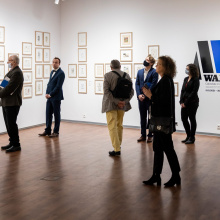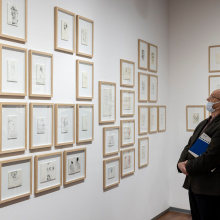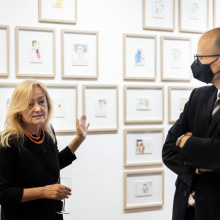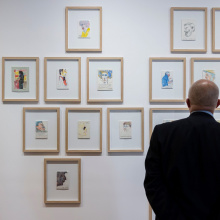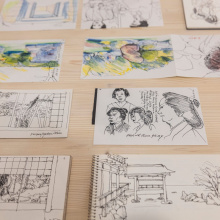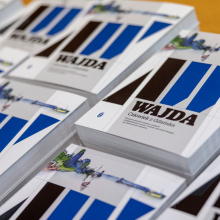- 'You will get to know Wajda from a different perspective. Not many people know this work,' announced prof. Krystyna Zachwatowicz-Wajda, the director's wife, during the opening of the exhibition of his drawings, sketches and watercolours. 160 works by the Master from notebooks and scrapbooks, documenting his life, passions and fascinations, can be viewed in the lecture theatre of the Main Library of the University of Gdańsk. This is the largest exhibition to date of Wajda's artistic works from his archives at the Manggha Museum.
The exhibition entitled Wajda. A man from Gdańsk is a broad presentation of little-known graphic and painting works of one of the most eminent Polish directors. So far, his artistic works have been shown several times, but never so many and so varied. The exhibits have been made available by the Manggha Museum of Japanese Art and Technology, established over a quarter of a century ago on the initiative of Andrzej Wajda's foundation.
Andrzej Wajda's drawings, sketches and watercolours are a kind of artistic biography. They are characterised by an abbreviated approach to the subject, providing an overview of the interests and development of the filmmaker, whose childhood dream was painting.
At the exhibition in BUG, the meeting with creativity opens with the first works in the form of colourful, abstract compositions, which were created while still a student at the Academy of Fine Arts in Cracow. Film directing was not the artist's first degree. As Anna Król, the curator of the exhibition at BUG, emphasised, the director's first love was the painting department at the Academy in Cracow.
As a student, Andrzej Wajda demanded a lot from himself and was critical about his painting. A breakthrough moment in his artistic development was an encounter with the works and talent of his friend Andrzej Wróblewski. - 'It was then that he realised that painting was not his path," recalled prof. Krystyna Zachwatowicz-Wajda. - I believe he had great artistic talent. He drew fantastically, but he knew that it would not absorb him completely,' she added.
As the artist's wife stressed, her husband never used a camera. His form of communication with the world was drawing. - 'I was the one to take pictures,' recalled prof. Krystyna Zachwatowicz. Andrzej Wajda always carried a scrapbook, a notebook and a black crayon with him to sketch. Later, he would often complement his monochromatic works with colours. When he did not have his notebook with him, he would draw on whatever was at hand - on sheets of paper or notebook pages, ruled or checked, as if it was his life's need for the immediate, graphic registration of the moment. - 'It was a constant, compulsive drawing of the world and people. And the exhibition is like being with it through a different medium,' - explained Anna Król, curator of the exhibition.
Portrait, landscape and frame
A large, perhaps even larger part of the exhibition in BUG is taken up by portraits. Often drawn in a hurry, with a few well-defined pen, crayon or marker lines, they reflect the characteristic features of famous faces from the artistic world of the '80s and '90s. Among them, besides the portraits of his wife, there are images of many friends and acquaintances of the Master, often accompanied by personal comments.
On small sheets, sometimes scraps of paper, we recognise unforgettable faces of the world of cinema and culture, such as Piotr Skrzynecki, Gustaw Holoubek, Stanisław Lem, Sławomir Mrozek, Józef Czapski or Robert Altman. But also people, figures from the director's life and his civic and political involvement such as Lech Wałęsa, Jacek Kuroń, the Dalai Lama or Tadeusz Fiszbach.
An extremely interesting part of the exhibition, especially for film scholars, are sketches and materials concerning film productions and theatre performances. The director believed that drawings, painted portraits or landscapes stayed in his memory better and moved his imagination more. In his work as a director, drawing was like a way to communicate quickly with his co-workers. - 'Through these working materials, made by the director, we enter an intimate artistic space,' - argued Anna Król, the exhibition's curator.
In the showcases of the exhibition, there are many storyboards of scenes, i.e. drawn scripts, which were the artist's detailed vision and guidelines for the production of films. The yellowed sheets show the stages of the artist's work - scenes and shots from Kanał, Popiół i diament, Ziemia Obiecana or Pan Tadeusz. - 'Precisely drawn scenes, which will be seen by the eye of the camera. Mini-plans showing specific directions and steps of actors on the set in particular scenes. I had no idea that this was what a film backstage looked like,' said Ms. Bożena from Gdańsk, who visited the exhibition.
Among the presented works there are also animals and views from the journey, including many images of Japan, its architecture or scenes from the traditional theatre. Here, the artist used a composition in the style of Japanese woodcuts of the Edo period, providing a visual means of describing the flowing, ephemeral world.
The exhibition is accompanied by a special catalogue published by the University of Gdansk Publishing House. As Joanna Kamień, editor-in-chief of the UG Publishing House, emphasised, it will remain a lasting memento at the University after the end of the exhibition.
The exhibition entitled Wajda. A Man from Gdańsk can be viewed until January 30, 2022, from Tuesday to Friday from 12.00 to 17.00 and on Saturday from 10.00 to 15.00.
Honorary patrons of the exhibition: prof. Krystyna Zachwatowicz-Wajda, Mieczysław Struk, Marshall of the Pomorskie Voivodeship, Aleksandra Dulkiewicz, Mayor of the City of Gdańsk, Wojciech Szczurek, Mayor of the City of Gdynia and Jacek Karnowski, Mayor of the City of Sopot.
Patrons of the exhibition: Głuchowski Siemiątkowski Zwara Law Firm. Attorneys and Legal Advisors. Exhibition partner: OMIDA Logistics. Pomeranian Voivodeship self-government. The city of Gdańsk. Financial support: Nowosielski & Partners. Attorneys and Legal Advisors. We thank companies and institutions for their financial support of this event.
Media patrons: Gazeta Wyborcza, portal gdansk.pl, Radio Gdansk, trójmiasto.pl, Magazine Prestiż Trójmiasto, Radio Mors and University Gazette.
Photographs: Tomasz Nowicki

